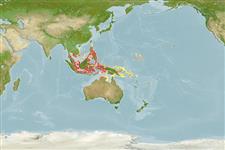Teleostei (teleosts) >
Callionymiformes (Dragonets) >
Callionymidae (Dragonets)
Etymology: Dactylopus: Greek, daktylos = finger + Greek, pous = foot (Ref. 45335); kuiteri: Named in honor of the collector, Rudie H. Kuiter of Seaford, Victoria, Australia (Ref. 35443).
More on author: Fricke.
Environment: milieu / climate zone / depth range / distribution range
Ecology
Marine; demersal; depth range 3 - 15 m (Ref. 48636). Tropical
Western Central Pacific: Indonesia.
Size / Weight / Age
Maturity: Lm ? range ? - ? cm
Max length : 15.0 cm TL male/unsexed; (Ref. 48636)
Short description
Identification keys | Morphology | Morphometrics
Dorsal spines (total): 4; Dorsal soft rays (total): 9; Anal spines: 0; Anal soft rays: 8. 3 dorsal points on the preopercular spine, the male's first spine of the first dorsal fin longer than the second spine, no filaments in the first dorsal fin, black and orange first and second dorsal fins, and a white head and body with black-edged orange streaks on the head and anterior back (Ref. 35443).
Collected from a sandy bottom (Ref. 35443). May occur solitary or in pairs (Ref. 90102).
Life cycle and mating behavior
Maturities | Reproduction | Spawnings | Egg(s) | Fecundities | Larvae
Fricke, R., 1992. Synchiropus kuiteri, a minute new dragonet (Callionymidae) from Flores, Indonesia. Rev. Fr. Aquariol. 19(3):81-84. (Ref. 35443)
IUCN Red List Status (Ref. 130435)
Threat to humans
Harmless
Human uses
Tools
Special reports
Download XML
Internet sources
Estimates based on models
Preferred temperature (Ref.
123201): 28.3 - 29.2, mean 28.8 °C (based on 471 cells).
Phylogenetic diversity index (Ref.
82804): PD
50 = 0.7500 [Uniqueness, from 0.5 = low to 2.0 = high].
Bayesian length-weight: a=0.01148 (0.00455 - 0.02896), b=2.92 (2.70 - 3.14), in cm total length, based on LWR estimates for this (Sub)family-body shape (Ref.
93245).
Trophic level (Ref.
69278): 3.3 ±0.4 se; based on size and trophs of closest relatives
Resilience (Ref.
120179): High, minimum population doubling time less than 15 months (Preliminary K or Fecundity.).
Fishing Vulnerability (Ref.
59153): Low vulnerability (10 of 100).
